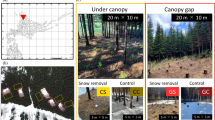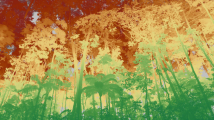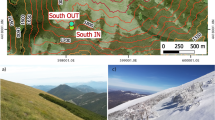Abstract
Autumn phenology plays a critical role in shaping the carbon sequestration capacity of temperate forests. Notable local-scale variations in autumn phenology have drawn increasing attention recently, potentially introducing substantial uncertainty when predicting temperate forest productivity. Yet the underpinning mechanisms driving these variations remain inadequately elucidated. Here we observed significant and consistent relationships between canopy structure and autumn phenology across six temperate forest sites, induced by the regulation effect of canopy structure on microclimate conditions. Incorporating the identified ‘canopy structure–microclimate–autumn phenology’ pathway into existing autumn phenology models significantly improves the prediction accuracy and reduces the projected delay in the start of autumn over the remainder of the century. These findings offer a new perspective for interpreting the local variations of autumn phenology in temperate forests and emphasize the urgent need to integrate the identified pathway into the Earth system and vegetation models, especially considering the asynchronous changes of macroclimate and microclimate conditions.
This is a preview of subscription content, access via your institution
Access options
Access Nature and 54 other Nature Portfolio journals
Get Nature+, our best-value online-access subscription
27,99 € / 30 days
cancel any time
Subscribe to this journal
Receive 12 print issues and online access
209,00 € per year
only 17,42 € per issue
Buy this article
- Purchase on SpringerLink
- Instant access to full article PDF
Prices may be subject to local taxes which are calculated during checkout





Similar content being viewed by others
Data availability
The generated autumn phenology data, canopy structural attributes, microclimate simulation results, and terrain features, as well as the collected macroclimate records and in situ microclimate observations, are accessible via Figshare at https://doi.org/10.6084/m9.figshare.26064097 (ref. 54). The original NEON field measurements and airborne lidar data can be accessed via https://www.neonscience.org/, the National Forest Type Dataset through https://data.fs.usda.gov/geodata/rastergateway/forest_type/, the MODIS MCD43A1, MCD12Q2, and MOD15A2H data through https://www.earthdata.nasa.gov/, the ERA5 macroclimate data through https://cds.climate.copernicus.eu/ and the projected future macroclimate data through https://esgf-node.llnl.gov/projects/cmip6/ and https://cds.climate.copernicus.eu/.
Code availability
The complete R (version 4.2.3) and python (version 3.8) code used for the calculation and visualization of the results are accessible via Figshare at https://doi.org/10.6084/m9.figshare.26064097 (ref. 54).
References
Piao, S. et al. Plant phenology and global climate change: current progresses and challenges. Glob. Change Biol. 25, 1922–1940 (2019).
Keenan, T. F. et al. Net carbon uptake has increased through warming-induced changes in temperate forest phenology. Nat. Clim. Change 4, 598–604 (2014).
Menzel, A. & Fabian, P. Growing season extended in Europe. Nature 397, 659 (1999).
Yang, H. et al. Global increase in biomass carbon stock dominated by growth of northern young forests over past decade. Nat. Geosci. 16, 886–892 (2023).
Piao, S. et al. Characteristics, drivers and feedbacks of global greening. Nat. Rev. Earth Environ. 1, 14–27 (2019).
Dufrêne, E. et al. Modelling carbon and water cycles in a beech forest. Ecol. Model. 185, 407–436 (2005).
Zani, D., Crowther, T. W., Mo, L., Renner, S. S. & Zohner, C. M. Increased growing-season productivity drives earlier autumn leaf senescence in temperate trees. Science 370, 1066–1071 (2020).
Gallinat, A. S., Primack, R. B. & Wagner, D. L. Autumn, the neglected season in climate change research. Trends Ecol. Evol. 30, 169–176 (2015).
Vitasse, Y. et al. Impact of microclimatic conditions and resource availability on spring and autumn phenology of temperate tree seedlings. New Phytol. 232, 537–550 (2021).
Fracheboud, Y. et al. The control of autumn senescence in European Aspen. Plant Physiol. 149, 1982–1991 (2009).
Wu, S. et al. Monitoring tree-crown scale autumn leaf phenology in a temperate forest with an integration of PlanetScope and drone remote sensing observations. ISPRS J. Photogramm. Remote Sens. 171, 36–48 (2021).
Castède, S. et al. Genetic determinism of phenological traits highly affected by climate change in Prunus avium: flowering date dissected into chilling and heat requirements. New Phytol. 202, 703–715 (2014).
Deslauriers, A. & Rossi, S. Metabolic memory in the phenological events of plants: looking beyond climatic factors. Tree Physiol. 39, 1272–1276 (2019).
Vitasse, Y., Bresson, C. C., Kremer, A., Michalet, R. & Delzon, S. Quantifying phenological plasticity to temperature in two temperate tree species: quantifying plasticity of leaf phenology. Funct. Ecol. 24, 1211–1218 (2010).
Liu, Q. et al. Delayed autumn phenology in the Northern Hemisphere is related to change in both climate and spring phenology. Glob. Change Biol. 22, 3702–3711 (2016).
Chen, L. et al. Leaf senescence exhibits stronger climatic responses during warm than during cold autumns. Nat. Clim. Change 10, 777–780 (2020).
De Frenne, P. et al. Forest microclimates and climate change: importance, drivers and future research agenda. Glob. Change Biol. 27, 2279–2297 (2021).
Zellweger, F. et al. Forest microclimate dynamics drive plant responses to warming. Science 368, 772–775 (2020).
Jucker, T. et al. Canopy structure and topography jointly constrain the microclimate of human-modified tropical landscapes. Glob. Change Biol. 24, 5243–5258 (2018).
Smith-Tripp, S. M., Eskelson, B. N. I., Coops, N. C. & Schwartz, N. B. Canopy height impacts on the growing season and monthly microclimate in a burned forest of British Columbia, Canada. Agric. Meteorol. 323, 109067 (2022).
Moeser, D., Roubinek, J., Schleppi, P., Morsdorf, F. & Jonas, T. Canopy closure, LAI and radiation transfer from airborne LiDAR synthetic images. Agric. Meteorol. 197, 158–168 (2014).
Zhao, Y. et al. Evaluating fine-scale phenology from PlanetScope satellites with ground observations across temperate forests in eastern North America. Remote Sens. Environ. 283, 113310 (2022).
Maclean, I. M. D. & Klinges, D. H. Microclimc: a mechanistic model of above, below and within-canopy microclimate. Ecol. Model. 451, 109567 (2021).
Canham, C. D. An index for understory light levels in and around canopy gaps. Ecology 69, 1634–1638 (1988).
Zellweger, F. et al. Estimating below-canopy light regimes using airborne laser scanning: an application to plant community analysis. Ecol. Evol. 9, 9149–9159 (2019).
Ruefenacht, B. et al. Conterminous U.S. and Alaska forest type mapping using forest inventory and analysis data. Photogramm. Eng. Remote Sens. 74, 1379–1388 (2008).
Lefcheck, J. S. piecewiseSEM: piecewise structural equation modelling in R for ecology, evolution, and systematics. Methods Ecol. Evol. 7, 573–579 (2016).
Qiao, Y. et al. Accelerating effects of growing-season warming on tree seasonal activities are progressively disappearing. Curr. Biol. 33, 3625–3633 (2023).
Way, D. A. & Montgomery, R. A. Photoperiod constraints on tree phenology, performance and migration in a warming world. Plant Cell Environ. 38, 1725–1736 (2015).
Wu, C. et al. Widespread decline in winds delayed autumn foliar senescence over high latitudes. Proc. Natl Acad. Sci. USA 118, e2015821118 (2021).
Vinod, N. et al. Thermal sensitivity across forest vertical profiles: patterns, mechanisms, and ecological implications. New Phytol. 237, 22–47 (2023).
Zohner, C. M. et al. Effect of climate warming on the timing of autumn leaf senescence reverses after the summer solstice. Science 381, eadf5098 (2023).
Lang, W., Chen, X., Qian, S., Liu, G. & Piao, S. A new process-based model for predicting autumn phenology: how is leaf senescence controlled by photoperiod and temperature coupling? Agric. Meteorol. 268, 124–135 (2019).
Jeong, S. & Medvigy, D. Macroscale prediction of autumn leaf coloration throughout the continental United States. Glob. Ecol. Biogeogr. 23, 1245–1254 (2014).
Hufkens, K., Basler, D., Milliman, T., Melaas, E. K. & Richardson, A. D. An integrated phenology modelling framework in R. Methods Ecol. Evol. 9, 1276–1285 (2018).
Richardson, A. D. et al. Climate change, phenology, and phenological control of vegetation feedbacks to the climate system. Agric. Meteorol. 169, 156–173 (2013).
Haesen, S. et al. ForestTemp—sub-canopy microclimate temperatures of European forests. Glob. Change Biol. 27, 6307–6319 (2021).
Friedl, M. A. et al. MODIS Collection 5 global land cover: algorithm refinements and characterization of new datasets. Remote Sens. Environ. 114, 168–182 (2010).
Photosynthetically active radiation (PAR) (DP1.00024.001), RELEASE-2024. NEON https://doi.org/10.48443/vmjd-yy64 (2024).
Triple aspirated air temperature (DP1.00003.001), RELEASE-2024. NEON https://doi.org/10.48443/pde7-k607 (2024).
Single aspirated air temperature (DP1.00002.001), RELEASE-2024. NEON https://doi.org/10.48443/rr7n-7d52 (2024).
Suri, M., Huld, T., Cebecauer, T. & Dunlop, E. D. Geographic aspects of photovoltaics in Europe: contribution of the PVGIS website. IEEE J. Sel. Top. Appl. Earth Obs. Remote Sens. 1, 34–41 (2008).
Soil physical and chemical properties, Megapit (DP1.00096.001), RELEASE-2024. NEON https://doi.org/10.48443/s6nd-q840 (2024).
Zhang, M., Liang, W. J. & Zhang, X. K. Soil nematode abundance and diversity in different forest types at Changbai Mountain, China. Zool. Stud. 51, 619–626 (2012).
Hersbach, H. et al. The ERA5 global reanalysis. Q. J. R. Meteorol. Soc. 146, 1999–2049 (2020).
Sun, Y. et al. Field-based estimation of net primary productivity and its above- and belowground partitioning in global grasslands. J. Geophys. Res. Biogeosciences 126, e2021JG006472 (2021).
Anderson, M. J. & Cribble, N. A. Partitioning the variation among spatial, temporal and environmental components in a multivariate data set. Aust. J. Ecol. 23, 158–167 (1998).
Greenwell, B. M. pdp: an R package for constructing partial dependence plots. R J. 9, 421–436 (2017).
Friedl, M., Gray, J., Sulla-Menashe, D. MODIS/terra+aqua land cover dynamics yearly L3 global 500 m SIN grid V061. NASA EOSDIS Land Processes Distributed Active Archive Center https://doi.org/10.5067/MODIS/MCD12Q2.061 (2022).
Myneni, R., Knyazikhin, Y., Park, T. MODIS/terra leaf area index/FPAR 8-Day L4 global 500 m SIN grid V061. NASA EOSDIS Land Processes Distributed Active Archive Center https://doi.org/10.5067/MODIS/MOD15A2H.061 (2021).
Douglas, H. C. et al. Changes to population-based emergence of climate change from CMIP5 to CMIP6. Environ. Res. Lett. 18, 014013 (2023).
Danabasoglu, G. et al. The community earth system model version 2 (CESM2). J. Adv. Model. Earth Syst. 12, e2019MS001916 (2020).
Müller, W. A. et al. A higher‐resolution version of the Max Planck Institute Earth System Model (MPI‐ESM1.2‐HR). J. Adv. Model. Earth Syst. 10, 1383–1413 (2018).
Wu, X. Y. et al. Code and data for ‘canopy structure regulates autumn phenology by mediating microclimate in temperate forests’. Figshare https://doi.org/10.6084/m9.figshare.26064097 (2024).
Acknowledgements
This study was supported by National Key R&D Program of China grant 2022YFF0803100, National Natural Science Foundation of China grants 42201408 and 31922090, Office of China Postdoc Council International Postdoctoral Exchange Fellowship YJ20210322 and the Innovation and Technology Fund (funding support to State Key Laboratories in Hong Kong of Agrobiotechnology) of the HKSAR, China. The tree elements in Fig. 4 were adapted from the design of Freepik.
Author information
Authors and Affiliations
Contributions
Y.S. and X.W. designed this study. X.W. and C.N. developed the methodology and conducted the investigation, with contributions from Y.S. Y.S. and X.W. handled the visualization. The study was supervised by Y.S. X.W., C.N. and Y.S. wrote the original draft, with all authors contributing to the review and editing process.
Corresponding author
Ethics declarations
Competing interests
Authors declare that they have no competing interests.
Peer review
Peer review information
Nature Climate Change thanks David H. Klinges and the other, anonymous, reviewer(s) for their contribution to the peer review of this work.
Additional information
Publisher’s note Springer Nature remains neutral with regard to jurisdictional claims in published maps and institutional affiliations.
Extended data
Extended Data Fig. 1 Location, drone imagery, and autumn phenology metrics of the Changbai Mountain (CBS) site.
a, Map of the CBS site with the background illustrating forest types, derived from moderate resolution imaging spectroradiometer (MODIS) MCD12Q1 product. ENF, EBF, DNF, DBF, and MF represent evergreen needleleaf forest, evergreen broadleaf forest, deciduous needleleaf forest, deciduous broadleaf forest, and mixed forest. The boundary line was obtained from the National Catalogue Service For Geographic Information. b, Drone image collected in the day of year (DOY) of 235 exhibiting the vegetation conditions before the start of autumn (SOA). c, Drone image collected in the DOY of 295 exhibiting the vegetation conditions after the end of autumn. d, Map of SOA for the CBS site, derived from drone images. e, Map of the duration of autumn (DOA) for the CBS site, derived from drone images. f, Box plots of SOA and DOA within the CBS site. Grey dots in the background represent data points of 10 × 10 m grid cells (number of samples = 109). The central vertical lines in each box represent the mean, and whiskers limits were calculated as 1.5 times of the interquartile range from the box limits.
Extended Data Fig. 2 Relationships between canopy structure, microclimate and autumn phenology metrics within the CBS site.
a, Relationships of SOA and DOA with plant area index (PAI) and canopy height. b, Relationships of SOA and DOA with global light index (GLI) and temperature buffering (Tbuffer). GLI and Tbuffer were derived from the simulated microclimate data (average values from 1 July to 31 August). All relationships were evaluated using the linear mixed-effects method with tree species as the random effect. The significance of the correlations was evaluated using a two-tailed t-test. Solid lines represent significant fitted lines (P < 0.05), and a confidence interval of 95% is shown (grey error bands).
Supplementary information
Supplementary Information
Supplementary methods, Tables 1–7 and Figs. 1–12.
Rights and permissions
Springer Nature or its licensor (e.g. a society or other partner) holds exclusive rights to this article under a publishing agreement with the author(s) or other rightsholder(s); author self-archiving of the accepted manuscript version of this article is solely governed by the terms of such publishing agreement and applicable law.
About this article
Cite this article
Wu, X., Niu, C., Liu, X. et al. Canopy structure regulates autumn phenology by mediating the microclimate in temperate forests. Nat. Clim. Chang. 14, 1299–1305 (2024). https://doi.org/10.1038/s41558-024-02164-2
Received:
Accepted:
Published:
Issue Date:
DOI: https://doi.org/10.1038/s41558-024-02164-2
This article is cited by
-
Tree species composition governs urban phenological responses to warming
Nature Communications (2025)
-
Microclimate regulates when autumn leaves fall
Nature Climate Change (2024)



